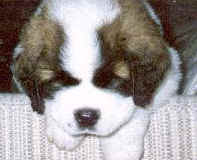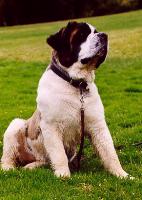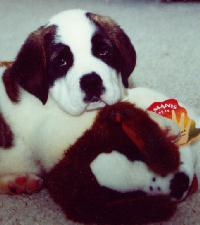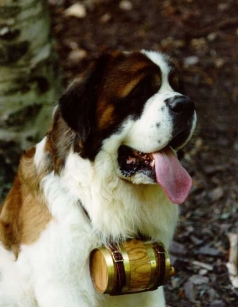ST. BERNARD (St.Bernhardshund, Bernhardiner)

FCI-Standard N° 61 / 21. 01. 2004 / GB
TRANSLATION : Mrs.C.Seidler and Mrs. Pepper.
ORIGIN : Switzerland.
DATE OF PUBLICATION OF THE VALID ORIGINAL STANDARD : 29.10.2003.
UTILIZATION : Companion-, watch- and farmdog.
CLASSIFICATION F.C.I.: Group 2 Pinscher and Schnauzer type, Molossians, Swiss Mountain-and Cattledogs and other breeds.
Section 2.2 Molossian type, Mountain type.
Without working trial.
SUGGESTED BREEDINGS by MENANDPETS.COM:
No breeding to signal
if you want to know like signaling yours, contacts: marketing@inseparabile.it
BRIEF HISTORICAL SURVEY : At the height of the Great St. Bernard Pass, 2469 metres above sea level, a hospice was founded by monks in the 11th century as a place of refuge for travellers and pilgrims. There, large mountain dogs have been kept since the middle of the 17th century for guarding and protection. The existence of such dogs has been documented pictorially since 1695 and in a written document at the hospice in the year 1707. The dogs were soon in use as companion dogs and specially as rescue dogs for travellers lost in snow and fog. The chronicles about the numerous human lives saved by these dogs from the « white death », published in many languages, and the verbal reports of the soldiers who crossed the pass with Bonaparte’s army in 1800, spread the fame of the St. Bernard, called Barry-dog at that time, throughout Europe during the 19th century. The legendary dog « Barry » became the epitome of the rescue dog. The direct ancestors of the St. Bernard were the large farm dogs common in that region. Within a few generations and aiming to a defined ideal type, these dogs were developed to the present day type of breed. Heinrich Schumacher from Holligen near Bern was the first who began to issue genealogical documents for his dogs in 1867.
In February 1884 the "Schweizerisches Hundestammbuch"(SHSB), the Swiss Dog Stud Book, was started. The very first entry was the St.Bernard "Leon", and the following 28 registrations also concerned St.Bernards. On the 15th March 1884, the Swiss St.Bernards-Club was founded in Basle. On the occasion of an international Canine Congress on June 2nd 1887, the St. Bernard dog was officially recognized as a Swiss breed and the breed standard was declared as binding. Since then , the St.Bernard has been regarded as the Swiss national dog.
GENERAL APPEARANCE :
There are two varieties of the St.Bernard :
- Short-haired variety (double coat, “Stockhaar”):
- Long-haired variety.
Both varieties are of considerable size and of impressive general apperance. They have a balanced, powerful, sturdy, muscular body with impressive head and an alert facial expression.
IMPORTANT PROPORTIONS :
- Ideal relation of height at withers to length of body (measured from the point of the shoulder to the point of buttocks) = 9 : 10.
- Ideal relation of height at withers to depth of chest see sketch below.
- The total length of the head is slightly more than one third of the height at withers.
- The relation of depth of muzzle (measured at its root) to length of muzzle is almost 2:1.
- Length of muzzle slightly longer than one third of the total length of the head.
BEHAVIOUR/TEMPERAMENT:
Friendly by nature. Temperament calm to lively; watchful.
HEAD :
General : Powerful, imposing and very expressive.
CRANIAL REGION :
Skull : Strong, broad, seen in profile and from the front slightly rounded. When the dog is alert, the set-on of the ears and the top of the skull form a straight line which slopes at the sides in a gentle curve to the strongly developed high cheek bones. Forehead falling away steeply towards the muzzle. Occipital bone only moderately developed, superciliary ridges strongly developed. The frontal furrow, which starts at the base of the forehead, is distinctly developed and runs up right in the middle of the skull.
The skin of the forehead forms slight wrinkles above the eyes that convergetowards the frontal furrow. When the dog is at attention, they are moderately visible; otherwise they are rather inconspicuous.
Stop : Dinstinctly pronounced.
FACIAL REGION :
Nose : Black, broad and square. Nostrils well opened.
Muzzle : Of even width. Nasal bridge straight, with slight groove.
Lips : Edge of lips black pigmented. Flews of upper jaw strongly developed, firm and not too pendulous, forming a wide curve towards the nose. Corners of mouth remain visible.
Jaws/Teeth : Upper and lower jaw strong, broad, equal in length. Well developed, regular and complete scissor or pincer bite. Close fitting undershot mouth without any space between the lower and the upper incisors acceptable. Absence of PM 1 (premolar 1) and M3tolerated.
Eyes : Of medium size. Colour dark brown to nut-brown. Moderately deep set with a friendly expression. Natural tightness of lids desired. A small angular fold on the lower lids with the haws only slightly visible as well as a small fold on the upper lids are permitted. Eyerims completely pigmented.
Ears : Of medium size, set on high and wide. Strongly developed burrs. Flaps pliable, triangular with rounded tips. The rear edges slightly standing off, the front edges lying closely to the cheeks.
NECK : Strong and of sufficient length. Dewlap and loose skin on the neck moderately developed.
BODY :
General : General appearance imposing, balanced, impressive and well muscled.
Withers : Well defined.
Back : Broad, strong, firm. Topline straight and horizontal upto the loins.
Croup : Long, hardly sloping, merging gently with the root of the tail.
Chest : Brisket moderately deep with well sprung ribs, but not barrel-shaped. Not projecting below elbow level.
Belly and underline : Slight tuck up towards rear.
TAIL : Set-on broad and strong. Tail long and heavy. The last vertebra reaching at least to the hock joint. When in repose, the tail
hangs straight down or slightly upturned in the lower third. When animated, it is carried higher.
LIMBS
FOREQUARTERS :
General : Forelegs straight and parallel seen from the front. Standing moderately broad.
Shoulders : Shoulder blades oblique, muscular and well attached to the chest wall.
Upper arm : Longer than the shoulder blade. Angle between shoulder blade and upper arm not too blunt.
Elbow : Close fitting.
Forearm : Straight, strong in bone, with lean musculature.
Pasterns : Seen from the front vertical in prolongation of the forearms; slightly oblique seen from the side.
Forefeet : Broad, with strong, tight, well arched toes.
HINDQUARTERS :
General : Muscular with moderate angulation. Seen from the back, hind legs are parallel, not standing closely together.
Upper thigh : Strong, muscular, broad.
Stifle : Well angulated, turning neither in nor out.
Lower thigh : Slanting and rather long.
Hock joints : Slightly angulated, firm.
Metatarsus : Straight and parallel when seen from GO BACK TO LIST.
Hind feet : Broad, with strong, tight, well arched toes. Dewclaws tolerated if they do not hinder the movement.
GAIT / MOVEMENT : Harmonious far reaching movement with good drive from the hindquarters, the back remaining stable and firm. Front and hind feet move forward in a straight line.
COAT
HAIR :
- Short-haired variety (Stockhaar, double coat) : Topcoat dense, smooth; close-lying and coarse. Plenty of undercoat. Thighs with slight breeches. Tail covered with dense hair.
- Long-haired variety : Topcoat plain, of medium length with plenty of undercoat. Short hair on face and ear; hair over the haunches and the croup usually somewhat wavy. Front legs feathered. Thighs with good breeches. Bushy tail.
COLOUR : Primary colour white with smaller or larger reddish-brown patches (splash-coated dogs) up to an unbroken reddish-brown mantle covering back and flanks (mantle dogs). A broken reddish-brown mantle is of equal value. A brindle reddish-brown colour permissible. Brownish-yellow tolerated. Dark shadings on head desirable. Slight touch of black on body tolerated.
Required white markings : Chest, feet, tip of tail, muzzle band, blaze and patch on neck.
Desirable markings : White collar. Symmetrical dark mask.
SIZE :
Height at withers : For dogs minimum 70 cm,
for bitches minimum 65 cm.
For dogs maximum 90 cm,
for bitches maximum 80 cm.
Dogs which exceed the maximum height will not be penalised, provided their general appearance is balanced and their movement is correct.
FAULTS : Any departure from the foregoing points should be considered a fault and the seriousness, with which the fault should be regarded, should be in exact proportion to its degree.
- Lack of sexual characteristics.
- Unbalanced general appearance.
- Too short legs in relation to size (short-legged).
- Heavy folds on head and neck.
- Muzzle too short or too long.
- Flews of the lower jaw turning outwards.
- Missing teeth other than PM 1 (premolar 1) and M3. Small teeth (especially incisors).
- Slightly undershot mouth.
- Light eyes.
- Eyelids too loose.
- Sway back or roach back.
- Croup higher than withers or falling away.
- Tail carried curled on the back.
- Absence of required markings.
- Crooked or severely turned out front legs.
- Poorly angulated, open-hocked or cow-hocked hindquarters.
- Faulty movement.
- Curly coat.
- Incomplete or totally absent pigmentation on nose leather, around the nose, on the lips or the eyelids.
- Faulty primary colour e.g. reddish-brown dots or ticks in the white.
ELIMINATING FAULTS
- Weak temperament, aggressiveness.
- Overshot mouth, distinctly undershot mouth.
- Wall eye.
- Ectropion, entropion.
- Solid white or solid reddish-brown coat (absence of the primary colour).
- Coat of any other colour.
- Height at withers below minimum size.
Any dog clearly showing physical or behavioural abnormalities shall be disqualified.
N.B. : Male animals should have two apparently normal testicles fully descended into the scrotum.
This amended breed standard will become effective from April 2004.
Automatic translate from inseparabile.com
Description:
The Saint Bernardo a large, strong dog much, muscoloso one, with one powerful head. Finch the weight of the dog remains proporzionato to its height, devout estimated high and devout. There are two types of cape: rough and smooth. In both
the cases the hair much driven in one and introduces in the color white man with of the spots brown rossiccio, red, black mahogany and, in various combinations. The snout and the orecchie usually are vanished with black and the intelligent and sweet lespressione. In the exemplary with the rough cape, the hair leggermente devout along and appears piumato in thighs and the legs. The wide leg and the fingers have a good arcatura that allows to the Saint Bernardo one sure walk also on the snow and the ice. They have a fiuto strongly developed and moreover it seems have a sixth sense to nellavvertire imminent dangers of storms or avalanches.
Temperament:

They are extremely sweet, friendly and tolerant with the children. The Saint pacific and slow Bernardo in the movements, obedient patient and. And a dog much loyal one. Seen the remarkable mola of this race, opportune to socialize to lesemplare since of Saint Bernardo cucciolo, holding it to contact with people. And much intelligent and easy one to train, however is advised to begin laddestramento in the first months of life of the dog, when still manageable measure has one. In fact a indisciplinato dog of this format, difficult to govern also for a person much fort and if it comes trained in public zones necessary luso of a leash so as to to have full load control on the dog. The saint Bernardo a good dog from guard thanks also for its size that acts as from deterrent.
Height and weight:

Height: females cm 61; males cm 70.
Weight:
females kg 50; males kg 91.
Problems of health:
These dogs enjoy
good health but some is tilts to the syndrome of wobbler. They can have of the problems to the skin, the heart, can be subject to the falling dysplasia dellanca and the inferior eyelid. In these can pu to manifest the phenomenon of the turned upside down stomach and therefore opportune to subdivide their meal in two or three small meal.
Living conditions:
The Saint Bernardo star well also in apartment, if adequately trained. Practically they are inatti to you allinterno and sufficient to have a small garden in order to make it to move a poin libert. They can living calmly allaperto even if they would prefer living with their family. They have one low tolerance to the warmth, therefore to the too much warm rooms and the long travels or pauses in automobile.
Exercise:

One long walk every sufficient day sar in order to maintain the just saint Bernardo in good conditions. As far as the puppys, their boneses would not have to be strained too much at least finch not they are formed completely. Therefore of the short walks and i
you play not too much extends are from advising finch the dog to you does not have approximately two years of ET, if affection from dysplasia is not wanted to be incurred in the possibilit of having a Saint adult Bernardo.
Longevit:
Approximately 8 10 years.
Maintenance:

Both types of capes are easy to hold. One vigorous brushed every day sufficient in order to maintain in order the just saint Bernardo. A beautiful if only necessary advised bath and with a delicate soap seen that the shampoo pu to eliminate the oleose substances del hair del dog. Particular attention must be made during the bath not to make to enter in contact the eyes with annoying substances which shampoo or the soap.
Origin:
The saint Bernardo one race much ancient one. And state founded in 980 from St Bernard de Menthon like shelter for the travellers through the dangerous alpine step between Switzerland and lItalia. It comes down from the mastiff tibetano and therefore it must around have origin with mastiff the capacities from Roman allanno 1000. Then the monaci probably they intercrossed lantico mastiff with the great Danish and the Great Pyrenei. Luso and the popolarit of the Saint Bernardo as dog from the 17 alpine aid century is begun around to the met of. Devout of 2000 persons they have been saved from this exceptional dog. After to have found dispersed or the wounded the leccano and they are close for dargli heat finch does not arrive the men of the alpine aid informs to you from an other Saint Bernardo. These dogs have fiuto a a lot developed that person also under various meters of snow allows to find it one. The avalanches are famous moreover for theirs cos said sixth sense in previewing perch perhaps succeed to feel of the frequencies many lowlands, than lorecchio human not in a position to perceiving. As gi said two variet exists of Saint Bernardo: to short hair and long hair. The variet to hair short devout used for the job in mountain perch in a position to tolerating rigid the devout temperatures, while in that one to long hair they can be formed easy of the ghiaccioli.
STANDARD
Origin: Switzerland
|
|
Use: Dog of company, from guard and pastorizia |
|
|
On Inseparable |
|
|
In The Web |
|
© menandpets All rights reserved.
|